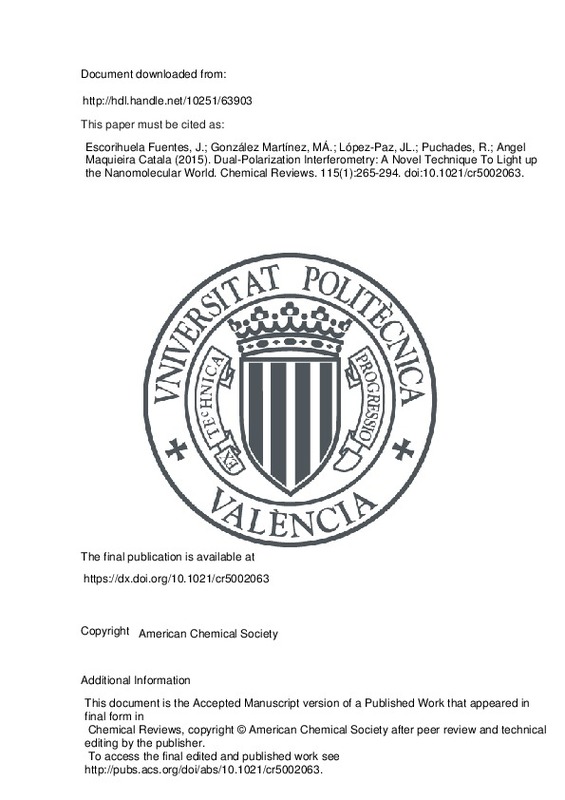|
Resumen:
|
[EN] The challenging lecture given in 1959 by physicist and Nobel Prize awarded R. P. Feynman:
“There's plenty of room at the bottom” is considered to be the starting point for
nanotechnology. With this peculiar title, ...[+]
[EN] The challenging lecture given in 1959 by physicist and Nobel Prize awarded R. P. Feynman:
“There's plenty of room at the bottom” is considered to be the starting point for
nanotechnology. With this peculiar title, Feynman encouraged researchers to explore
beyond the atomic level and predicted exciting new phenomena that might revolutionize
science and technology. Among these pioneering researchers are Eric Betzig, Stefan W. Hell
and William E. Moerner, who have been awarded with the Nobel Prize in Chemistry 2014
for developing the super-resolved fluorescence microscopy. However, it is important to
remark that the exploration of this amazing nanomolecular world began in the early 1980s
with the invention of the scanning tunneling1 and the atomic force microscopes2 (Figure 1).
Figure 1. Measurement scales.
The study and manipulation of interactions of nanometric dimensions could begin as
soon as measuring tools became more efficient. The last decades have witnessed the
development of techniques able to obtain information at the sub-molecular level, and their
applications especially on the biomedical field. As an example, the stimulating labor of
studying the role of conformational dynamics in reaction mechanisms has resulted in
Nanometers
10-1 10 102 103 1 104 105 106 107 108
DPI WORLD
Atom IgG Erythrocyte Grain of salt Tennis ball
Glucose Virus Amoeba Plea
numerous advances in life sciences.3 In this regard, the precise knowledge about molecular
interactions and their effects on protein function has greatly aided the discovery of new
targets in medical chemistry.
Figure 2. General scheme of different DPI applications.
The role of the structure in the protein behavior is a fundamental step in the
utilization, characterization and understanding of numerous biological processes.
Consequently, highly advanced functional and structural measurement tools have been
developed over the last decadess.4 Particularly, nuclear magnetic resonance (NMR), X-ray
crystallography and neutron reflectivity (NR) provide structural measurements, whereas
tools such as microcalorimetry or surface plasmon resonance (SPR) provide functional data.
Furthermore, the more recent approach based on Dual Polarization Interferometry (DPI), is
allowing the molecular interactions to be quantitatively measured at nanometric dimensions.
DPI is currently one of the most powerful label-free biosensing techniques in
heterogeneous format to record real-time data of conformational dynamics, which is
efficiently employed in different applications, such as bionanotechnology, surface science,
Biotechnology
Drug
Discovery
Lipid
Studies
Crystallography
Surface
Science
DPI
and crystallography or drug discovery (Figure 2). Their measurements can provide
information about the connection between the biomolecule function and its structural
changes. This technique is, to our knowledge, the most well-built and well-thought through
such waveguide sensor. It has its weaknesses, e.g. the necessity of using a relatively long
sensor element, but the information it delivers is the interaction of two polarization modes
of the propagating light with a molecular film at the top of the waveguide with which it
interacts through the evanescent field. It is well known that the use of an interferometric
readout and a long waveguide makes the measurements very stable and more accurate than
those of the competitor techniques. Accordingly, DPI can be described as a molecular ruler
whose quantitative values can be correlated directly with those from other usual techniques,
such as NMR, X-ray crystallography and NR, providing higher sensitivity and accuracy than
the classical acoustic and optical biosensors.
In 1996, Dr Neville Freeman conceived of the idea behind DPI as a robust and
reproducible biosensing technology and, together with Dr Graham Cross, developed the
concept and filed the original patent.5,6 This novel technique has gained popularity among
the scientific community in the last decade and the number of publications dealing with this
technique has increased considerably since the initial report in 2003.7 In this review, DPI is
compared with other techniques, and its theoretical basis and applications are outlined.
The fundamentals are specified together with strategies for chip functionalization and
applications of the aforementioned technology in a wide variety of research areas. All this
gives a unique chance to learn from this sensing technique, which may be an essential
reference to facilitate the work of future users.
[-]
|
|
Agradecimientos:
|
We thank Dr. Marcus Swann and Dr. Sergi Morals, with whom we have had many helpful discussions about DPI sensing and interferometry in general. We acknowledge financial support from the Generalitat Valenciana (GVA-PROMET ...[+]
We thank Dr. Marcus Swann and Dr. Sergi Morals, with whom we have had many helpful discussions about DPI sensing and interferometry in general. We acknowledge financial support from the Generalitat Valenciana (GVA-PROMETEO/2010/008) as well as the Spanish Ministry of Economy and Competitiveness and the European Regional Development Fund under award numbers CTQ2013-45875-R and CTQ2013-42914-R.
[-]
|







![[Cerrado]](/themes/UPV/images/candado.png)


